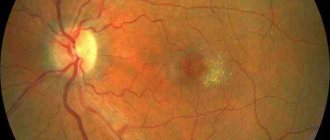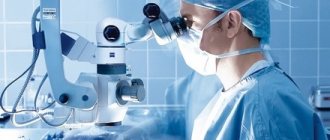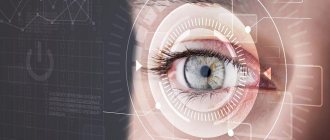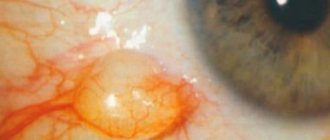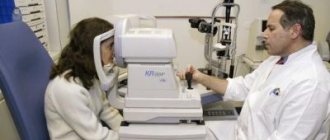Research principles
Adherents of this research method argue that one of the main distinctive advantages of iridology is its ease of implementation.
It does not involve any tactile or mechanical contact with the patient's eyes, since the iris is easily accessible for inspection. In addition, this method does not require preparatory procedures. It has no contraindications and is performed absolutely painlessly for the patient, in comfortable conditions. Supporters of iridology consider the results of such studies to be highly accurate and believe that on their basis it is possible to reliably determine the development of pathologies at the earliest stages, even before this can be done using traditional methods.
This allows you to promptly identify weak “links” in the body and give valuable recommendations regarding prevention, treatment, or simply changing the patient’s lifestyle. According to supporters of the method, with the help of iridodiagnostic research it is possible to determine not only the state of individual body systems (cardiovascular, musculoskeletal, sensory, etc.)
), but also its certain constitutional features, as well as the person’s stress level. In specialized research centers, diagnostics are usually carried out by trained specialists, who during the examination also take into account the traditional clinical manifestations (symptoms) of the disease and give a comprehensive conclusion.
- The iris contains points of each organ of the human body.
- The results are deciphered using the Iridologist's Atlas (map of the cornea of the eye).
- In case of problems affecting a certain part of the body, the nature of the eye pattern changes.
- The pupil is surrounded by loops of blood vessels in the brain, lungs, mammary glands, genitourinary system, and bronchi.
- Two colors of the iris (brown and blue) are considered normal; the rest indicate pathology.
The reliability of the results of modern iridology is enhanced by connecting computer equipment to the iridoscope using a digital camera. Additional equipment allows you to photograph the iris pattern and display the image on a computer monitor. Thanks to the telemetric properties of the computer program, changes invisible to the eye are recognized, and a preliminary conclusion is drawn up and issued.
DIAGNOSTICS BY IRISES
Knowing the patterns of the irises and the meaning of the signals on them, it is possible to carry out iridodiagnosis, which allows you to see dysfunction of organs and their hidden weaknesses and pathology, find the causes of incomprehensible complaints and incomprehensible diseases, determine congenital characteristics and hereditary predispositions.Iridology is a sensitive biological method for detecting diseases, allowing one to notice pathological changes in organs long before their external manifestation or the appearance of obvious subjective symptoms.
The main result of iridology is that diagnosis by the irises of the eyes helps to treat more accurately, taking into account the hidden causes of the existing disease, the congenital characteristics of the patient and his heredity.
Diagnostics using the irises of the eyes can also be carried out on healthy people to identify weaknesses in the body, its individual characteristics and hereditary burden for the purpose of timely implementation of preventive measures and preventive treatment.
Iridodiagnosis can be performed on children from the age of five after the final formation of the iris picture.
Iridology is needed when...
1. You feel bad when you have complaints, but all tests, ultrasound, CT, MRI, etc. are normal, and doctors only advise to “treat your nerves”;
2. Diagnosis of eye diseases is needed when your disease is not clear to doctors
3. Diagnostics using the irises of the eyes will clarify the situation when your disease has been treated for a long time, but for some reason it stubbornly resists treatment;
4. With the help of iridology, it is possible to identify the leading pathology when there are several diseases at once and it is necessary to understand which of them is the most important;
5. Diagnosis of the body using the irises of the eyes makes it possible to identify the degree of risk of various hereditary diseases for the purpose of their early prevention and target organs for the purpose of their homeopathic organotropic treatment, as well as to determine congenital predispositions to diseases for their prevention;
Eye diagnostics is an ancient method for identifying diseases...
Determining diseases by the irises of the eyes was well known to doctors of the distant past. The secrets of eye diagnostics belonged to sacred knowledge and were passed on by ancient healers only by inheritance. The very first diagnostic diagrams of the irises of the eyes were found during excavations in the Egyptian pyramids. Modern technical capabilities make it possible to carry out iridology using digital photographic equipment, a computer and the Internet.
Diagnostic capabilities using irises...
The main advantage of iridology is its ability to determine: - the true causes of a painful condition in unknown diseases; — the underlying origin of the existing chronic recurrent disease; - create optimal targeted examination programs, which allows you to avoid conducting numerous and burdensome laboratory tests and consultations according to the principles: “just in case” or “the more research, the better.”
Diagnostics using the irises of the eyes allows for preliminary selection among practically healthy people to prescribe targeted studies (pre-screening) in cases of hereditary predispositions and diseases, occupational hazards, in asymptomatic forms of diseases and in latent forms of prenosological pathology.
Making a diagnosis using the iris: advantages of the method
Supporters of iridodiagnostics talk about the safety of such an examination. It is not invasive and therefore does not cause discomfort to humans. There are no contraindications to it, with the exception of increased sensitivity of the eyes to light. There are other advantages of iridodiagnostics, which its supporters talk about:
- does not require special training;
- carried out quickly and without the use of drugs;
- is not accompanied by side effects;
- Suitable for children and adults.
As for the accuracy of the technique, it is disputed. Let's consider the arguments of opponents of iridology.
Opinions on iridology
Among representatives of official medicine, disputes around the accuracy of iridodiagnosis results do not subside. The principle of examination using an unconventional method is associated with acupuncture, which is based on the statement that there is a relationship between internal organs and biologically active zones on the human body.
- problems with the gastrointestinal tract (ulcers, gastritis, cholecystitis, pancreatitis);
- pathologies of the liver, spleen, kidneys, genitourinary tract, and spine;
- development of cardiovascular and hormonal disorders, traces of emotional reactions.
Iridology best recognizes hereditary predisposition to diseases, the state of the body's reserve potential and metabolism. But the results of testing for diabetes and rheumatism, the presence of malignant tumors must be confirmed by additional studies. Moreover, injuries, inflammations and degenerative processes can be reflected on the iris with identical signs.
The essence of iridology
The iris is an automatic diaphragm that regulates the amount of light rays that hit the retina, the center of which is the pupil. It is very complex and has connections with almost all internal systems and organs. Therefore, it can be considered as a kind of screen onto which our organs are projected. When pathological changes appear, the projection on the iris also changes, which is manifested by a redistribution of the pigment of the iris.
During the examination, the doctor carefully examines the color of the iris (uniformity of pigment distribution, possible inclusions and darkening), its structure (direction of the fibers and their density), the condition of the outer edge of the iris and blood vessels. It describes the shape and size of the pupil, reveals the features of the pupillary border, as well as the pupillary reaction to a light stimulus.
Iridology specialists talk about the analogy of their method with the principles of acupuncture, which uses the connection that exists between the internal organs of a person and the areas of their projection on the skin. In general, modern science identifies five specific projection zones in the body that can signal the state of our health - the skin, the iris, the auricle, and the mucous membranes of the nose and tongue. The iridodiagnosis method uses special schemes currently developed that take into account the projection zones of internal organs on the iris, as well as special computer programs that greatly facilitate the doctor’s processing of examination results.
REDUCTION OF RESERVE FORCES OF THE ORGANISM IN MICROELEMENTS
— 320 — types of PARASITES in humans — Boxes must be full
• Helps identify the main causes of ailments • Determines the level of toxic damage to organs and tissues • Reveals microelement imbalance. • Deficiency of such vital microelements: Molybdenum, Zinc, Selenium, Iron, Iodine, Manganese, Copper, Chromium, Fluorine. • Shows the level of parasitic intoxication • Selects an individual health program
Warning Sign: Dry eyes that are very sensitive to light
What could this mean? Perhaps this refers to an autoimmune disease of the body, which is called sicca keratoconjunctivitis or sicca syndrome (Sjögren's syndrome). This pathology disrupts the functioning of the eye glands and oral glands, which are responsible for moisturizing these areas.
Additional signs indicating the presence of this disease. Sjögren's syndrome usually occurs in women over 40 who suffer from autoimmune diseases such as rheumatoid arthritis or lupus. Most often, the eyes and mouth are hit simultaneously. Such patients may also notice vaginal dryness, sinus dryness, and simply dry skin. Due to a lack of saliva, problems with chewing and swallowing occur.
What should I do? Sjögren's syndrome is diagnosed through special tests. To protect the eyes, it is usually necessary to use artificial moisturizers (for example, so-called artificial tears). It is also necessary to take care of improving the quality of nutrition, while increasing the amount of fluid consumed.
A little about the history of iridology
Iridology today is considered to be a relatively new research method, and at the same time it was used by ancient healers. Information about this was preserved, for example, in ancient Egyptian papyri, which were found during excavations in Giza of the tomb of the famous pharaoh Tutankhamun. In ancient India and China, healers also used the study of the condition of the iris of human eyes in the practice of identifying diseases of the body.
At the moment, iridology is a fairly popular diagnostic method, which is used by specialists from many of the world's leading medical centers, as well as research institutes. The first medical research institution in Russia to begin using iridology methods was the center created in Moscow at the Faculty of Medicine of Peoples' Friendship University, which was headed by the famous specialist in the field of reflexology E.S. Wellkhover. The center's staff developed special computer programs, the use of which made it possible to effectively diagnose various diseases (stomach ulcer, kidney stones, etc.).
